After conducting our baseline study to understand the current social situation for upperclassmen and graduate students at Stanford, we continued our search by reading relevant literature about the social activities of university students and testing existing applications that aim to help users make friends. We further developed grounded theories that integrate the study’s specific result and background literature’s general claims, system models that visually describe key social factors’ relationship, and proto-persona with journey maps that are essential to the next ideation stage. The end of this post presents 4 intervention ideas and delineates a specific intervention study to carry out.
Part 1
Grounded Theory
Grounded Theory 1: Students prefer dorm events over initializing social interactions by themselves to meet new friends
- Subtheory 1: Dorm events provide a natural incentive to attract people out of their comfort zone. Without dorm events, personal efforts to socialize feel weak in comparison to the comfortable facilities people have at home.
- Carl provided a negative experience example to support this claim. He talked about how his least favorite year was living in EVGR. He said that there were rarely ever events and the building had few natural common spaces for people to hang out. He mentioned the rooms being too comfortable and having too many accommodations so you never had to leave them. This meant he had no serendipitous interactions in EVGR because there was basically zero community, leading to his displeasure with the dorm. A vibrant social norm can not be built by a single person but can happen under a well-constructed event.
- How much does dorm architecture play into the dorm community versus effective RAs? Is there anything RAs can do to get around bad architecture?
- Carl provided a negative experience example to support this claim. He talked about how his least favorite year was living in EVGR. He said that there were rarely ever events and the building had few natural common spaces for people to hang out. He mentioned the rooms being too comfortable and having too many accommodations so you never had to leave them. This meant he had no serendipitous interactions in EVGR because there was basically zero community, leading to his displeasure with the dorm. A vibrant social norm can not be built by a single person but can happen under a well-constructed event.
- Subtheory 2: Casual settings where people gather semi-randomly are some of the most natural venues to socialize.
- Sasha shared how a common casual scenario in her dorm has helped his social life. He talked about how he would try to eat meals as much as possible in the dining room instead of elsewhere in the house like his room or in the living room. His motivation for this was twofold: 1) to chat with random people in the dorm on days when there weren’t many people and 2) to “break into” one of the larger friend groups that drew into Mars together this year. Sasha also mentioned that he struck up conversations with people in the hallway and bathroom quite a bit during his normal routine and that this experiment helped him ask more questions in those interactions. This turned them from simple hand waves and “hi” to longer 5-10 minute conversations where he actually learned more about them.
- What are effective ways for people to approach already formed friend groups and potentially join them? Are shared interests enough for this?
- How can we turn simple, serendipitous interactions into meaningful, informative conversations?
- Sasha shared how a common casual scenario in her dorm has helped his social life. He talked about how he would try to eat meals as much as possible in the dining room instead of elsewhere in the house like his room or in the living room. His motivation for this was twofold: 1) to chat with random people in the dorm on days when there weren’t many people and 2) to “break into” one of the larger friend groups that drew into Mars together this year. Sasha also mentioned that he struck up conversations with people in the hallway and bathroom quite a bit during his normal routine and that this experiment helped him ask more questions in those interactions. This turned them from simple hand waves and “hi” to longer 5-10 minute conversations where he actually learned more about them.
- Subtheory 3: An excellent RA designs effective programs to facilitate social interactions and community that fit the characteristics of the population of the dorm.
- Sasha talked about his favorite event from last year, “Midsommars” which was a Special D in the spring quarter that was a “last hurrah for many people who were graduating or going abroad.” This event was organized by the Mars RAs and some residents.
- Are some dorm events better at gathering people than others? Why?
- What can RAs do to maximize community engagement through dorm events?
- Sasha talked about his favorite event from last year, “Midsommars” which was a Special D in the spring quarter that was a “last hurrah for many people who were graduating or going abroad.” This event was organized by the Mars RAs and some residents.
Grounded Theory 2: It is harder to make new friends later in the year / later in your college journey
- Subtheory 1: People who have established friend groups are less interested in making new friends
- Tran and Sam talked about how once you have your group of friends, you are less likely to venture out and make the effort to meet new people. They mentioned how the process of meeting new people and forming new connections is “too much effort”. Because of how demanding the process felt, they avoided it.
- Alice talked about how it is less likely to find new people that fit into your existing friend group. Her motivation for meeting and interacting with new people was thus lower since she was not confident that it would lead to something meaningful long term.
- Sam, Michelle, and Alice were all grad students who already have established friend groups on campus and they talked about how they usually just hang out with them and have solidified those relationships over time. Instead of spending time meeting new people, they spent it hanging out with their existing friends.
- Logan talked about how their dorm consisted of three big draw groups and other people who were just on their own. They felt that this led to residents not forming new connections as much as people drew in with their friends and that is the set of people they choose to hang out with mostly.
- How can we make the process of meeting new people feel less demanding for people and reduce the pressure people feel in those situations?
- How do we make it less challenging for people to interact with already formed friend groups?
- Subtheory 3: Busy schedules make it hard to meet new people
- Tran mentioned one of the reasons she and the people around her were not taking as much initiative this quarter was partly attributed to the fact that everyone was taking tougher classes and had busier schedules. People spent a larger chunk of their time outside the dorm due to this.
- Logan talked about the fact they would have gone to certain dorm events if they had the time to be able to. They also spoke about how even though the dorm has nice people, they do not really meet or interact with new people since they are very busy and mostly not in the dorm as a result of that.
- How can we make the process of meeting new people easier for people with busy schedules while allowing it to be as organic as possible?
Grounded Theory 3: It is hard to start friendships without knowing common interests or backgrounds before.
- Subtheory: It is difficult to form friends across cultures/from different backgrounds
- Michelle mentioned that she did not enjoy ITALIC because they brought too many people from too many different disciplines, making it difficult to find common interests with many of her classmates.
- Chuqi, who is from China, described that she has to put in extra effort to “adapt to the culture gap” when talking with people. She feels different from the majority (people who grew up in the United States). She shared that coming from a different culture has often posed challenges in terms of adapting socially to life here.
- Questions: How can people who come from vastly different backgrounds more quickly and easily identify things they have in common? How can individuals overcome cultural and language gaps?
- Subtheory: Friendships often form among people of the same (school) year.
- Michelle established her closest friendships during her freshman year. Now as a coterm, many of her friends are also graduate students / are still of the same year.
- Tran mentioned that during their freshman year, they felt that everyone was looking for friends, and described the experience as “so different.”
- Sam shared the same sentiments as Tran above, and added that “grad students are like freshmen,” meaning that they often actively seek new friendships.
- Questions: What do all-frosh dorms do different from other dorms? How can we maintain this willingness to socialize with new people? How can we better connect people of the same year?
- Subtheory: It is easier to become friends with people from similar backgrounds or interests.
- Michelle took two gap quarters in Taiwan and surprisingly met and formed friendships with a lot of Stanford people. Also, the majority of her social interactions throughout her day are in class or at club meetings (places where people with a common interest gather).
- Chuqi, who typically only goes to her dorm events when she has friends to accompany her, decided to attend a dorm event alone because she enjoys listening to Taylor Swift songs (it was a listen-party type of event). She referred to this opportunity to listen to this music as an “external motivation.” She also considers herself a “pretty introverted person” and shared that the majority of her friends are introverts as well.
- Sasha mentioned the importance of commonalities like age, similar interests, and things going on (in life) for the formation of close relationships.
- Questions: How can we better connect people with common interests? How can we identify and apply effective sources of extrinsic motivation to encourage people to engage with each other?
Grounded Theory 4: Different architectural designs impact people’s social style greatly.
- Subtheory: it is much easier to start a conversation when people were relaxed in communal places.
- Sasha said her experiences have been“hit or miss for meals in mars, either lots or few ppl but always someone to sit and chat with.” It sounds like that people living in a more communal environment have more expectations of being accompanied regardless time, which is not something common in a hotel-like setting.
- Carl added that he’s been able to “meet new people all the time” as he usually “come back for lunch, talk w friend. if friends not here, talk with others in the dorm.” These descriptions show that seeing new faces is not a concern in a communal space.
- In contrast, participants in our diary study who live in graduate housing sometimes ran into 0 new people on their way from the main entrance to their room.
- Questions: How can we help people get into the mood of befriending more quickly when they are already close by?
- Subtheory: people come across fewer visitors when there are fewer communal places available.
- Chuqi said “we (Chuqi & her roommate) don’t bring friends to our dorm, maybe once or twice a quarter” in the context of the living room is only shared by her and her roommate, considered as a private space. Even when she brought in guests, she tends to spend time in her own room instead of the living room area as to not disturb her roommate.
- Alice also shared in her interview that “undergrad dorms are communal, easier to start a convo.” She had experiences staying in the library of the dorm with a bunch of friends for several hours consecutively, while this experience is hard to recreate in her current graduate dorm.
- Questions: Since we can not create more communal places, is there any virtual communal spaces we can create to facilitate people meeting new friend?
- Subtheory: it is more convenient to organize events and to attract attendants when there is a communal place people already frequent.
- Alice said a lot of floor-wide event hosted in evgr-a resulted non-fruitful result because people would just grab the on-call food and leave. Since these residents do not use the communal space often, they have less attachment and associate less relaxation with the space.
- Sam echoed Alice’s comment and continued commenting that “No common spaces where people hang out since everything is inside your living unit.” Moreover, he also “rarely see anyone in the lobby (if they do, just a small smile is exchanged)” without further interactions.
- Questions: What kind od activities would people want to stay longer?
- Subtheory: people spend more time chilling in their rooms with doors closed, and the extra step of knocking and waiting for a response creates friction for people to initiate conversations.
- Alice commented that “(my dorm – evgr-a) does feel like a hotel kind of style here,” where people tend to just use it as a place for solitary activities. She added that “the closed doors in the hallway feel intimidating to initiate conversations with your neighbor.”
- Carl shares a similar sentiment that “its easy to sit in evgr in big comfy room and not see anyone.”
- Questions: How do we encourage people to get out of their comfortable rooms?
Grounded Theory 5: Primarily introverts are interested in forming new relationships.
- Subtheory 1: Introverts are not as comfortable venturing out to meet new people, but they immensely value relationships and friendships
- Tran and Sam both considered themselves to be introverts. They talked about how their worst experiences of living in a dorm where when they were alone/did not have as many friends. They spoke about how while they were not very comfortable taking the initiative to meet new people, they valued friendships and relationships a lot and lack of those brought them unhappiness
- How can we make introverts feel more comfortable while meeting new people?
- Tran and Sam both considered themselves to be introverts. They talked about how their worst experiences of living in a dorm where when they were alone/did not have as many friends. They spoke about how while they were not very comfortable taking the initiative to meet new people, they valued friendships and relationships a lot and lack of those brought them unhappiness
- Subtheory 2: While introverts are interested in meeting new people, social interactions with new people are particularly draining.
- Logan and Sasha talked about how thinking of things to say to new people required a lot of thought and energy. Sasha specifically talked about how he’s normally someone to sit back and listen while absorbing information, so going out of his way to share information and talk more than listen is particularly draining. He followed that by saying he needs time in his room to recharge after social outings.
- Is there any way to make it less draining for introverts to be active in social contexts?
- What ways can introverts “socially recharge” while still in social situations? Would this help them to spend more time with friends and meeting new people?
- Sasha also talked about how he can sit in his room the entire day and be completely content without any social interaction. Compared to extroverts, who crave social interactions, Sasha must then go out of his daily routine in order to get social interaction and make new friends. He mentioned that he is trying to work on getting out of the room more while he’s doing work, saying that he has been trying to work more in the living room or dining room by himself or with others in his dorm. He said this has led to more spontaneous social interactions because of people walking by. This is also probably a function of where the living/dining rooms are located—Mars is much more open that EVGR for example.
- How can we get introverts to spend more time out of their comfort zone (their room or somewhere private) and into more communal spaces where they can meet more people and get used to more social interactions?
- Logan and Sasha talked about how thinking of things to say to new people required a lot of thought and energy. Sasha specifically talked about how he’s normally someone to sit back and listen while absorbing information, so going out of his way to share information and talk more than listen is particularly draining. He followed that by saying he needs time in his room to recharge after social outings.
- Subtheory 3: Introverts have needs to be extroverts sometimes, too.
- Tran responded in his interview that he is “Introverted around new people, but extroverted once comfortable.” This exemplifies that usually a mixture of social and solitary is required for people to be satisfied with their dorm experience.
- Carl states that he “definitely enjoy time with people but need alone time.” Sasha has a similar case where she thinks herself as introverted but more extroverted when drunk. Logan, another participant, also describes the situation in a succinct phrase “extrovertedly introvert.”
- Some external factors are likely to play a role in introvertedness and extrovertedness. From Michelle’s experience, “in a room full of introverts, I become extroverted, and vice versa.” Chuqi, though claimed as introverted, always wanted to “step out of my comfort zone.”
- Questions: How can we better match people when they are in the mood of “extrovertedness”?
System Models
Connection Circle
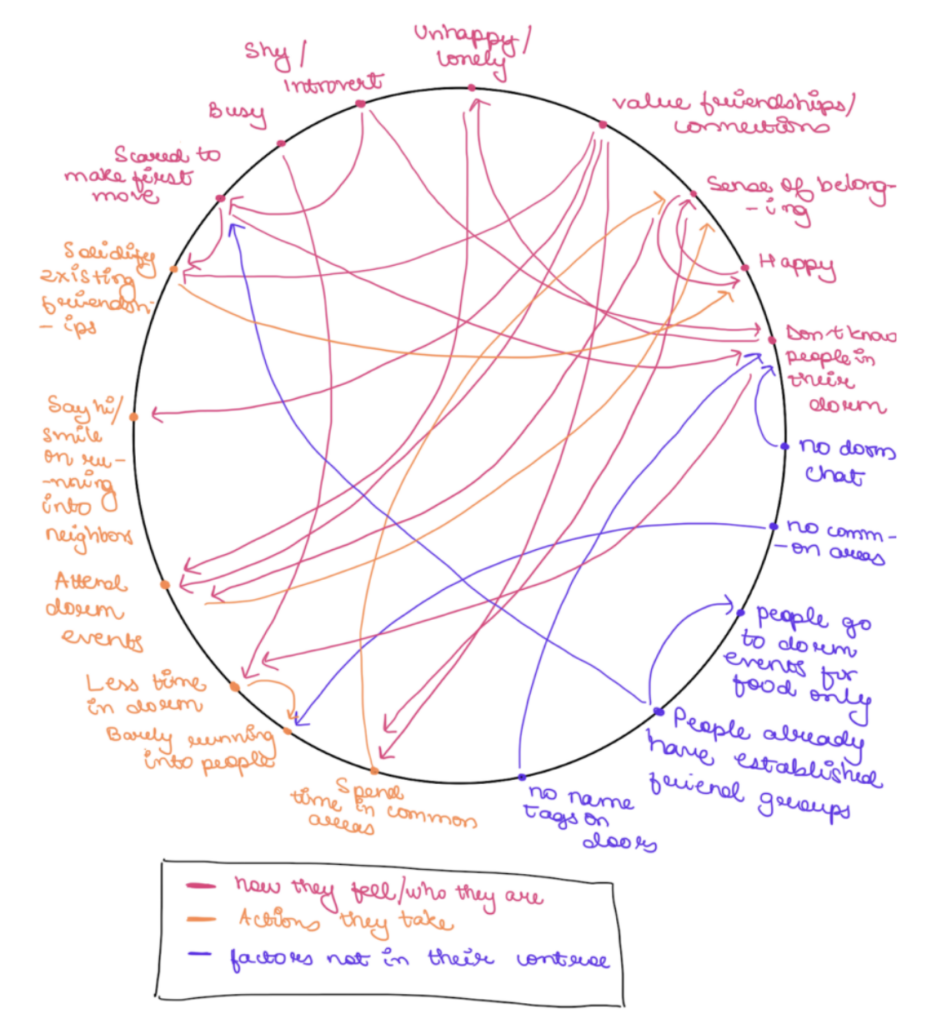
Process/Insights: Upon completing all of our interviews and the diary study, we noticed that there were 3 different categories of ideas– 1) red – How people feel/who they are (more about them), 2) yellow – Actions people take, and 3) purple – Factors not in their control. We color-coded our connection circle according to these 3 categories and made connections between them – this helped us better understand what was causing friction and helped us better ideate what to change so that people could see a positive change in context to this specific behavior. We observe that “having existing friendships” and “busy schedule” are two main factors that cause people to act in ways that are less likely to lead to new friendships.
Fishbone Diagram

Process/Insights: We reviewed the synthesis we completed from our interviews and noticed that dorm events are a common pain point for people. People have issues with (1) a lack of dorm of events, (2), being uninterested in existing dorm events, and (3) seeing people attend dorm events (ie. on calls) simply to take food and leave. However, successful dorm events can serve as a good medium for meaningful interactions, and consequently, friendships.
Feedback Loop
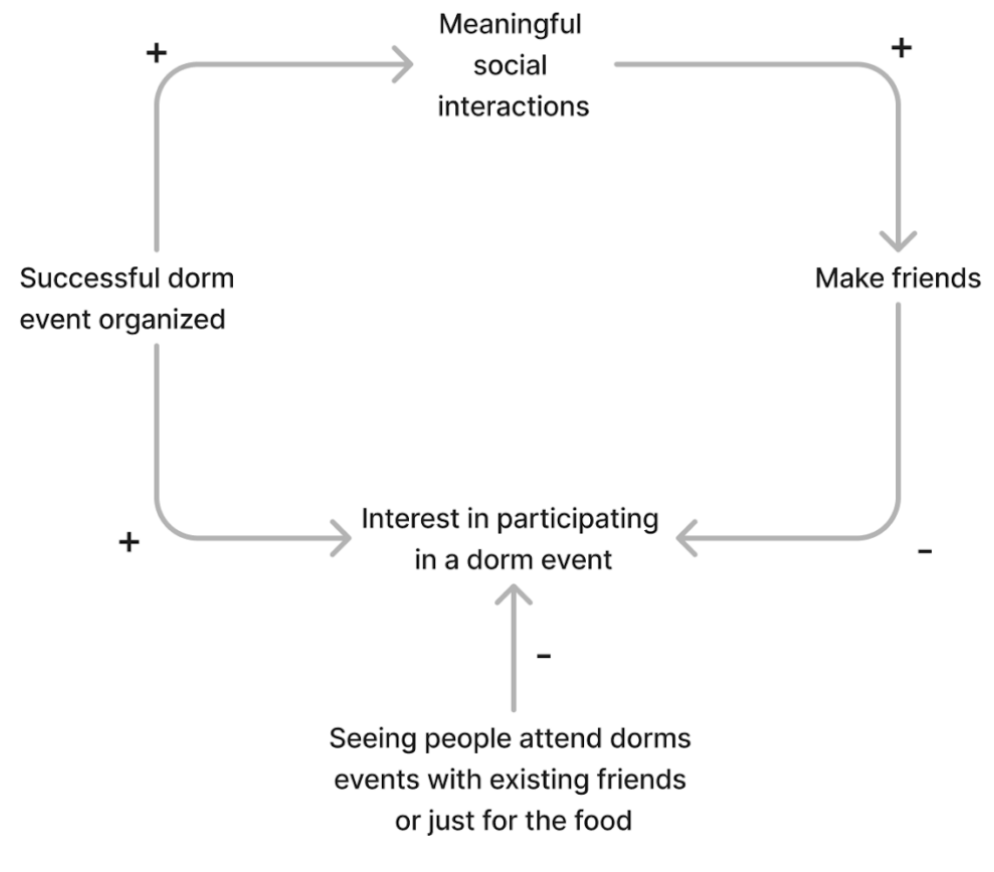
Process/Insights: We reviewed notes from the interviews and found a plethora of reasons why people exhibit anti-social behavior (especially introverts). We compiled these, grouping them into categories and providing examples shared by interviewees.
Secondary Research
Takeaways from Literative Review
The intersection of social dynamics, physical environment, and individual traits plays a crucial role in friendship formation and community integration within university settings. Studies highlight that common friends significantly influence the likelihood of new friendships, underscoring the importance of existing social networks in facilitating connections. Moreover, the physical structure of living spaces, such as low-rise versus high-rise dormitories, directly impacts students’ residential satisfaction and their ability to forge dormitory-based friendships, with those in low-rise settings reporting higher satisfaction and more connections. Additionally, individual challenges such as low trust, lack of time, introversion, and fear of rejection further complicate the landscape of social interaction, suggesting that both environmental design and personal interventions are necessary to foster a sense of community and facilitate meaningful social engagements among students. These insights call for a multidimensional approach in university planning and support services to enhance social integration and address the barriers to friendship formation.
Furthermore, we learn that in suites-based, students report less community overall, even though the personal amenities are usually better. They say that knowing dorm-mates before living with them leads to a better sense of community, especially in more cluster based housing. Experts recommend students take psychology classes to learn about how to handle conflicts in their relationships and practice what they learn in order to have better interpersonal relationships. Lastly, students should be placed in more inclusive environments in order to further interpersonal relationships and have better self confidence, especially if they are at all neurodiverse, where non neurodiverse students are less likely to interact with them in a normal environment.
Takeaways from Comparator Analysis
Analyzing the four social friend-making apps – Hey! VINA, Yubo, Meetup, and Befriend – reveals overarching trends in the market space of social networking apps aimed at facilitating friendships. First, there is a clear intention across the platforms to cater to specific demographic needs or interests, such as women seeking friendships in Hey! VINA, or teenagers and young adults in Yubo. This segmentation suggests a trend toward niche targeting rather than a one-size-fits-all approach. Second, the importance of user experience is evident, with each app attempting to differentiate through usability features, like Meetup’s event-centered interface or Befriend’s intuitive swiping mechanism. However, they also face challenges related to user engagement and safety, such as low active user counts and unmoderated content, respectively. Lastly, there’s a tension between facilitating genuine connections and the mechanics borrowed from dating apps, which may not always align with the users’ intentions to make friends.
For our team, these insights would influence the ideation phase in several ways. First, identifying a specific target audience or niche not adequately served by existing apps could provide a unique value proposition, such as focusing on people living in a dorm and wanting to meet new people on campus. Second, prioritizing a clean, intuitive user interface that encourages user interaction while clearly differentiating from dating app mechanics would be crucial to align with users’ expectations for friendship-focused interactions. Incorporating features that enhance user safety and community norms, alongside mechanisms that facilitate genuine connections (e.g., shared interests, group activities), could address prevalent user concerns. Lastly, considering innovative ways to increase user engagement, such as gamification or rewards for community-building activities, could help sustain a vibrant and active user base.
Looking at four more social, friend-making apps—Bumble BFF, NextDoor, Strava, and Hoop—we see similar trends of niche targeting. Strava and NextDoor are for athletic people and neighborhood communities, respectively; Hoop and Bumble BFF are ways for the youth to find friends more generally, who might be in their area. What’s interesting is each app’s very clear design language: the color scheme, where the buttons are, what buttons there are, and how quickly the app responds/transitions for your mental model. For example, Hoop feels very light, but cheap and like there aren’t very many helpful features. Bumble BFF, while accomplishing an almost identical goal, feels like there is more substance to it and feels friendlier because of the color scheme. From this, we know that we would want to emphasize a bright UI that is inviting and trustworthy. We shouldn’t put ads in the app because then users will feel attacked and get annoyed. We should also offer customizability that allows the user to control which information they want to share and explain exactly how they wish to share it.
From Strava and NextDoor, we should think about any specific niches we have. For instance, we are looking right now at dorm specific communities, so maybe leaning towards a college version of NextDoor, which is for neighborhoods, would be helpful. Maybe we end up finding some other key niche we want to explore, so depending on what that is, we should emphasize that in the app and build around it. From some of the interviews, we noticed that people only had social interaction while doing something else in their day: walking to class, interacting in class, eating lunch or dinner, doing homework. This could be a big insight, as it may give us something to design around!
Proto-personas

| Drawing | Name | Silent Listener Alex |
| Activated Role | A coterm student who is open to socializing but still finds meeting people tiring and sometimes pressuring. | |
| Goal | They love exploring and want to meet new people and have good interactions; deepen their current relationships inside and outside their residence. | |
| Motivation | They love knowing people more, seeing people where they go, and feeling comfortable wherever they go (by knowing them, it’s easier to talk to them). They really want to expand on these relationships and get to know people better by having longer form conversations instead of quick hellos. | |
| Conflict | They are worried about having a bad time socializing. They usually prefer spending time in their room working, instead of outside in more public/social settings because they find social interactions quite draining. They are stressed when they have to think of things to say and would much rather play a listening role in a conversation. | |
| Attempts to Solve | They try to spend more time working outside of their room when they are back at their dorm, such as in the dorm lounge, dining room, outside in the yard, etc. They also try going to dining halls during busy hours so they have a higher chance of running into people they met before and starting a new conversation. | |
| Setting/ Environment | Most of their interactions happen in their dorm (bathroom, hallways, dining room, lounge, room), but some happen on the way to class or in the class where they are a TA. | |
| Tools | Common social APPs like Instagram and Slack. They do not initialize conversations on those APPs often. They also have conversations with their existing friends online or offline whom they feel more relaxed to talk with. | |
| Skills | They are fantastic listeners who always get what people try to convey. They also make time for others and stick to plans instead of flaking. |

| Drawing | Name | Introvert Lonely Blake |
| Activated Role | Super introverted grad student who is new to campus | |
| Goal | They want to make friends and develop a sense of community on campus, specifically in their dorm. They want to feel less lonely and feel more adjusted to this new environment. | |
| Motivation | Navigating their first year at Stanford has been difficult without a strong support system. They do not have many people to spend time with outside of their classes. This sense of loneliness is impacting their mental health. | |
| Conflict | They have a strong motivation to make friends and spend time with others, but their shy personality makes them feel hesitant and nervous about approaching people. Furthermore, they live in a graduate student apartment where there are no common spaces, so opportunities to see new people don’t come often. They also don’t have a roommate. | |
| Attempts to Solve | They have tried to attend some events on campus, but they find that a lot of them are targeted towards undergraduates, whom they find that they cannot connect well with. Or, in many cases, they find that those who attend these events tend to go with people that they already know. Trying to join in on these existing groups feels uncomfortable. Occasionally, they will see their neighbors walking down the hallway, and they will greet them, but these conversations usually don’t last longer than a minute. | |
| Setting/ Environment | Most of their time is spent in their apartment alone. Most interactions with others in their day-to-day life are on the way to class (walking down the hall, in the elevator, walking across campus) or in their classes. Sometimes they sit and study in the yard outside their apartment or in public buildings like Old Union. | |
| Tools | They attend lab meetings and department gatherings but not really more personal social events. They use social apps like Instagram and follow friends’ feeds, but they do not react to the stories shared nor initiate conversations. | |
| Skills | They are dedicated to making their friends feel supported. They have a wide range of hobbies and interests. |
Journey Maps
Silent Listener Alex
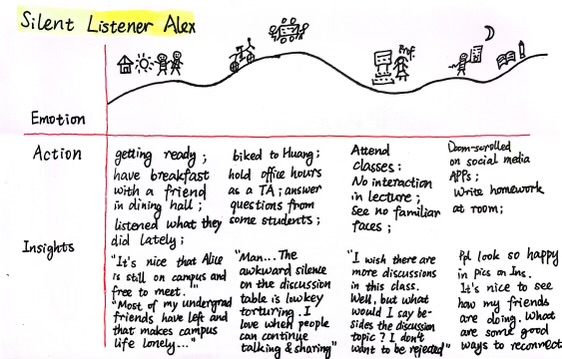
Introvert Lonely Blake
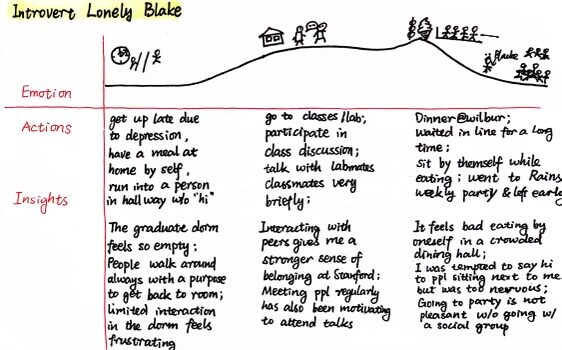
Part 2
Ideation
There were 4 main ideas that our team came up with to help upperclassmen including co-terms have better social experience on campus.
The first idea is to remind people of their social goals and record their progress to continue developing their friendships. The setting is a communal dorm where people bump into each other frequently in the restroom. The APP would nudge the user to pay attention to their efforts of socializing. By allowing users to monitor their actions and presenting visual gamified rewards when they unlock certain behaviors like finishing a coffee chat, the APPs can help people become more comfortable with reaching out to people and opening up conversations. The pros of this idea are that logging and reflecting on social interactions offer a clear lens for users to examine their behaviors and increase awareness of potential changes. The con side of this idea is that it might not be enough incentivizing for people who do not have a strong initiative to change their social behaviors, thus it won’t be as useful for these users.
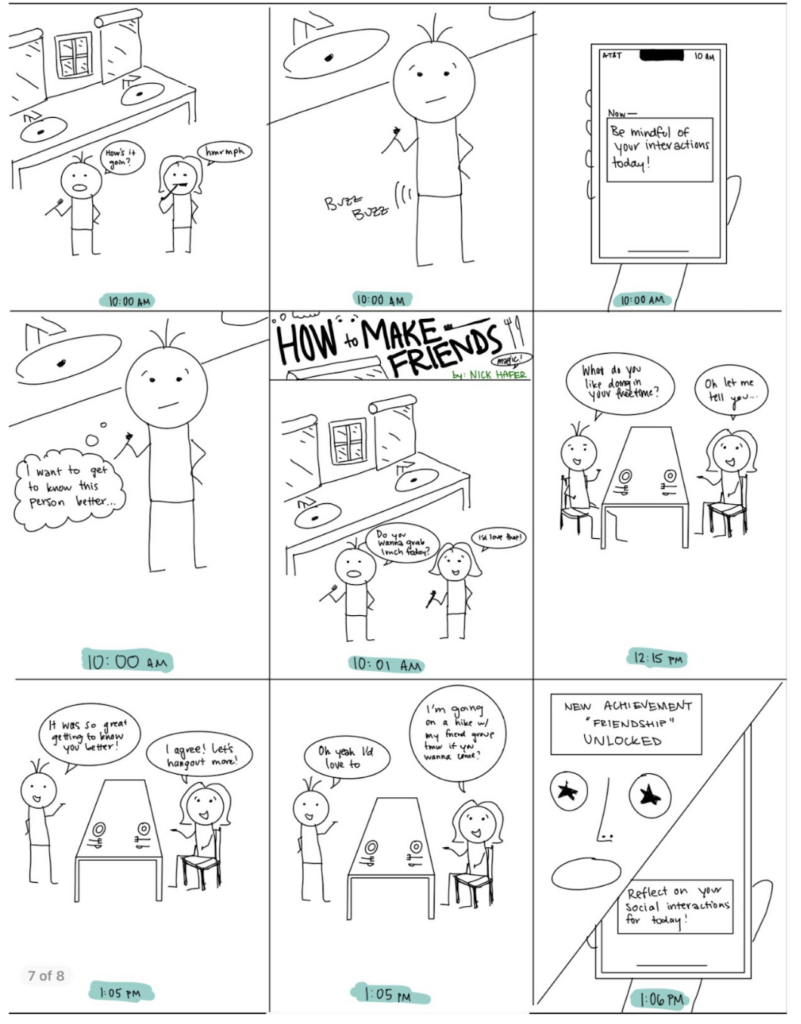
To reduce the friction of initializing meetups and accommodating students’ busy schedules on the Stanford campus, our second idea is to perform automatic matching given people’s calendar schedules. They could set their preferences in terms of what kind of people they want to meet (people they have never met before or friends they already met), what topics they are interested in, what activities they are open to doing together, and the option to decline a match if they dislike the current match’s profile. We heard positive feedback about this idea with people sharing their frustration with the tedious process of asking for availability and trying to pin down a time/place. The pros of this idea are that the matching is designed to be very flexible for many kinds of needs according to different personality types or hobbies. It’s different from the current scheduling APP by freeing users from multiple steps of confirming as we assume there is an algorithm taking care of people’s preferences, so users won’t have to do too many manual steps. However, there is a safety concern since the APP offers random matching with strangers, so there should be more features implemented to prevent incidents.
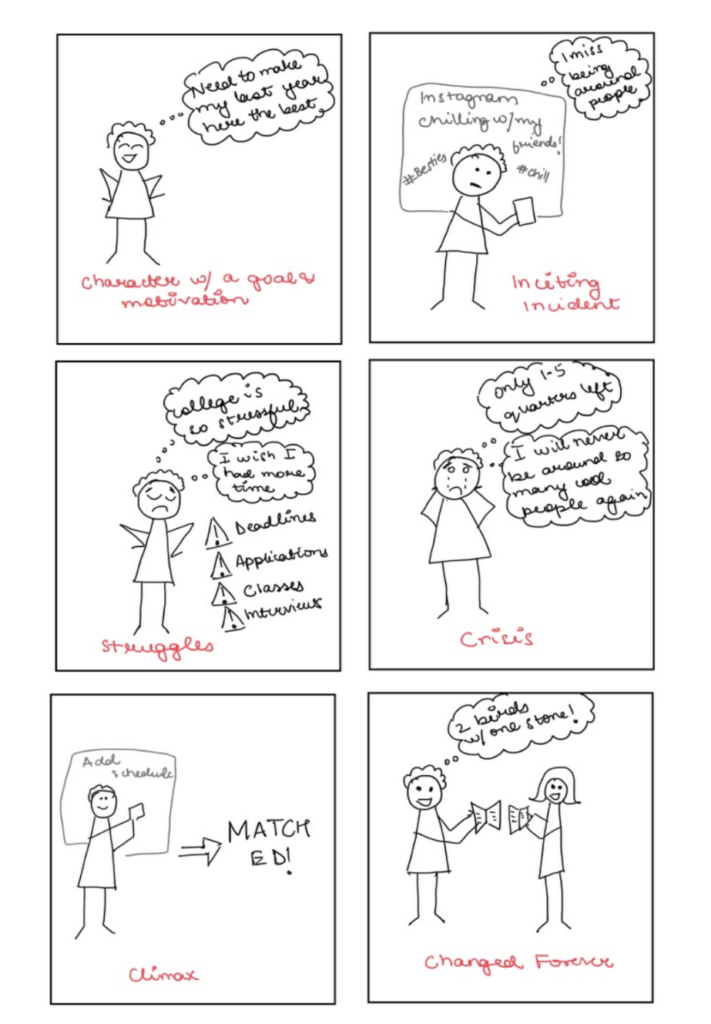
The next idea is centered around food exploration on campus as meal time is one of the most common occasions to meet old or new friends. Our diary study further verifies that with participants’ comments like “it is more relaxing if I am meeting someone while doing something like eating” and “it is kinda awkward to eat alone.” As dining hall foods are not always appealing and some people have strong interests in hobbies like restaurant exploration, this APP is designed to match people based on the restaurants they want to explore together, so they could go to the place they want and be accompanied. One challenge of this idea is that Stanford students are still flaky when they make plans so we want to implement punishment features like lower ratings on personal profiles or publicizing the percentage of flaking to ensure a good experience with the APP.
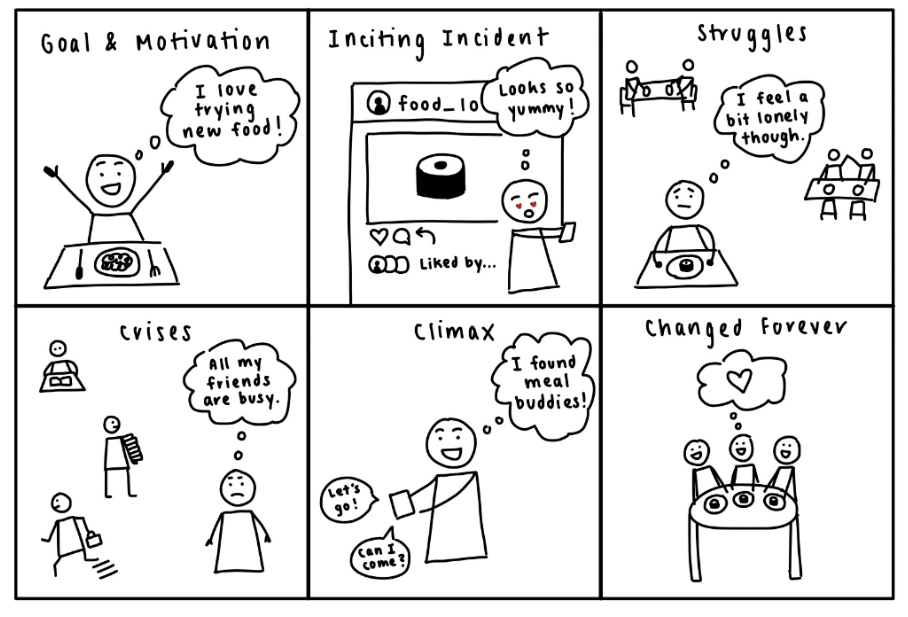
The last idea is our black-horse idea. It originates from the feedback about 30 seconds of saying hi in communal bathrooms feels too short to make a real connection. Thus, we want to create an APP that can nudge people to have a 5-minute-long talk instead to get to know each other better. The APP’s current functionality requires users to be more self-motivated about keeping long conversations, which filters out users who are interested in meeting new people but are still shy about talking with new people. However, the essence of the idea is to have a measurable task for people to make progress so that they can focus more on the action and less on being stuck and not knowing where to start next.
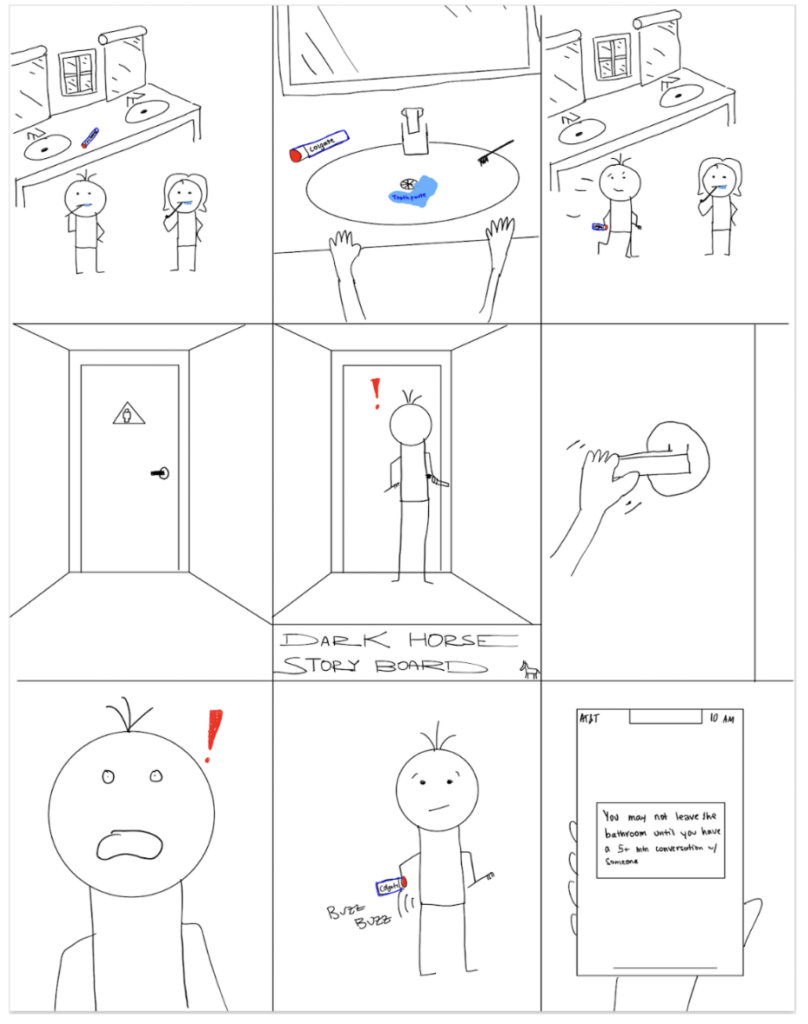
Intervention Study
With the feedback gathered from our ideation process, we decided to start with a small behavior – initiate and complete a conversation either with someone new or someone that participants already knew. The incentive for doing so is that we found being nervous or feeling unprepared is a common obstacle for our diary study participants to socialize with people.
The general scheme of our intervention study is the following: pick 1 prompt from the following or of your choice. Implement that in at least 1 interaction you will have during the day (preferably with someone you have not talked to before) and a small reflection form due at the end of each day to see if having something to talk about in their mind changed the quality of their interactions. The goal of this intervention study is to 1) evaluate how a given list of prompts may impact users’ conversation experience and to 2) test how users react to setting a small task per day like “using one prompt at least during the day.” The feedback from participants will affect our APP design. For example, participants’ preference between general and personalized conversational prompts would determine whether we allocate more space on the screen for personalization or focus on a clean screen with diverse general conversation starters. The acceptance level of participants in terms of completing a task and checking it off every day will also impact our design to help users track their progress in making social connections.
We have 9 participants in total, among whom we have 4 extroverts and 6 introverts. This is a nice split as we can have a comprehensive picture of how different personalities influence the nudging effects. Originally we wanted to work on only getting to know new people only, but a lot of our participants are introverts with stronger incentive to expand their social network, so this current setup is a valid foundation step to build up their confidence.
Below is the list of questions for our 5-day study. We will also send a Google form at the end of each day to ask for reflection on the interactions participants had. You can view our introduction and exit remarks for participants at this link.
Monday:
- Ask about their weekend
- Ask whether they watched the super bowl
- Ask how their week is looking and whether they need any support/help with the craziness of week 6
- Share one thing about yourself (recent joy/concern) and ask for feedback/help
Tuesday:
- Ask how their classes are going. Anything particularly challenging or exciting?
- Ask what they’re planning to have for their next meal
- Ask about their current favorite movie/show and get some recommendations for yourself!
- Did you watch the Grammys? Thoughts? If not, what kind of music do you listen to?
Wednesday:
- Ask about Valentine’s Day plans
- Exchange opinions on dining halls/food on campus
- How are your classes going? What’s your favorite and least favorite one so far?
- Ask if they have any crazy deadlines coming up and how they are dealing with that
Thursday:
- Ask how their Valentine’s Day was
- Ask about what classes they plan to take next quarter
- Ask about their summer plans
- Ask about their biking/walking experience on campus
Friday:
- Ask about their plans for the upcoming long weekend
- Ask how their week has been
- Share something interesting that happened to you over the week and ask for theirs
- Ask about their favorite sports and recent exercise experience, maybe you could be a sport partner!




Comments